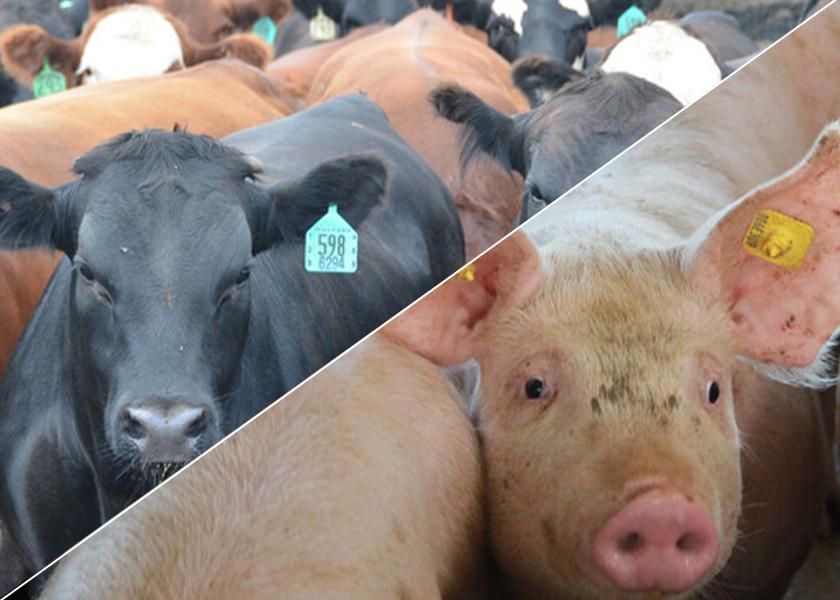Livestock Analysis | May 6, 2022

Price action: June lean hog futures fell $2.975 to $104.10, down $2.275 for the week.
5-day outlook: Solid losses signal followthrough technical selling pressure early next week, especially since today’s price action formed a bear flag pattern on the daily bar chart for June hogs. The sell-off in stock market late this week and the surge in the U.S. dollar index to a 20-year high today also dampened hog bulls’ spirits. If the stock market remains under selling pressure next week, which chart analysis suggests will be the case, then look for lean hog futures bulls to remain mostly standing on the sidelines.
Weak cash market fundamentals are the main bearish element for the sagging hog futures market. The CME latest lean hog index quote was down another 8 cents today (as of Wednesday) to $100.96, marking the seventh consecutive daily decline. And Thursday’s preliminary index quote is $100.91, down another 5 cents from Wednesday. The national direct five-day rolling average cash hog price today was quoted at $101.46. Pork cutout values fell 8 cents early today to $106.19, due to an $18.00 decline in bellies. Movement at noon today was 169.12 loads.
30-day outlook: Spring hog slaughter has confirmed the cyclical supply reductions reported in USDA’s March hogs and pigs report. That implies late-spring hog slaughter numbers will run 2%-4% under year-ago levels. Offsetting that bullish scenario, the demand side of the ledger remains highly questionable, especially given recent uninspiring U.S. pork export sales numbers and the U.S. dollar surging on the foreign exchange market. Still, cyclically and seasonally declining hog supplies and grilling-season demand may turn the cash and futures market around soon.
90-day outlook: Looking out over the horizon, the hog market bulls have two strong underlying fundamentals leaning in their favor: rising inflation, including a solid rise in food inflation, and a generally bullish raw commodity sector led by a resurgence in crude oil prices that this week pushed back above $110 a barrel. Red meat demand traditionally doesn’t seem to suffer all that badly during recessions.
What to do: Cover all soybean meal needs in the cash market through May. Be prepared to extend coverage on further price weakness. You are hand-to-mouth on corn-for-feed needs.
Hedgers: Carry all risk in the cash market for now.
Feed needs: You have all soybean meal needs covered in the cash market through May. Be prepared to extend coverage on price weakness. You are hand-to-mouth on corn-for-feed needs.
Price action: June live cattle futures fell $1.025 to $132.75, up 10 cents for the week. August feeder cattle rose 32.5 cents to $174.70.
5-day outlook: Choice beef cutout values fell $4.56 Thursday and fell another 48 cents to $246.43 early today, contributing to pressure on cattle futures. Nevertheless, after active fed cattle sales around $140 were reported in the Southern Plains earlier in the week, the Monday-Thursday average for the five-market area came in at $143.43, up 12 cents from the week-prior figure. This suggests market-ready fed cattle supplies, at least in northern areas, remain relatively tight and seemingly implies strength for next week’s cash outlook as well. However, the packers’ inability to persuade grocers to pay up for beef at this point, when wholesale demand is often the strongest of the year, doesn’t bode well for the late spring-summer fed cattle outlook. Ultimately, this seemingly confirms ideas inflated retail beef prices are stifling consumer demand.
30-day outlook: Grocers typically complete their buying for beef features over Memorial Day weekend by mid-May, with some sustained buying into the third week of May likely reflecting purchases for beef features over the first weekend in June. If wholesale prices remain weak through that period, they will look vulnerable to larger losses through late spring and into summer. With the supply of fed cattle increasing seasonally as summer looms, the combination of weak demand and large supplies apparently implies a comparatively large seasonal drop in cash prices in late May and early June. June futures are already forecasting a sizeable drop, so they might stabilize at some point in the weeks just ahead.
90-day outlook: Our research shows U.S. beef stockpiles grew during March, as they did this year, just four times in the past 20 years. A comparison of the cash cattle market in those years reveals a strong tendency for larger spring-summer losses than in other years. The March stocks increase likely reflects years when consumer beef demand is not holding up well, with the persistence of that phenomenon apparently tending to exaggerate the usual second quarter drop in live cattle prices. We think the possibility of a repeat of that phenomenon is relatively high. This is the reason we are seeking opportunities to hedge at least a portion of third quarter marketings.
What to do: Cover all soybean meal needs in the cash market through May. Be prepared to extend coverage on further price weakness. You are hand-to-mouth on corn-for-feed needs.
Hedgers: Carry all risk in the cash market for now.
Feed needs: You have all soybean meal needs covered in the cash market through May. Be prepared to extend coverage on price weakness. You are hand-to-mouth on corn-for-feed needs.






